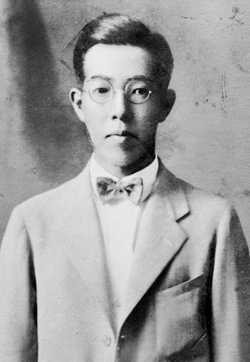Jiro Horikoshi
| Jiro Horikoshi | |
|---|---|
 when Horikoshi was a student of the Faculty of Engineering, Tokyo Imperial University | |
| Born |
22 June 1903 Fujioka, Gunma Prefecture |
| Died | 11 January 1982 |
| Nationality | Japanese |
| Education | University of Tokyo |
| Engineering career | |
| Significant projects | A7M "Reppu" |
| Significant design |
A5M A6M "Zero" J2M "Raiden" |
Dr. Jiro Horikoshi (堀越 二郎 Horikoshi Jirō, 22 June 1903 - 11 January 1982) was the chief engineer of many Japanese fighter designs of World War II, including the Mitsubishi A6M Zero fighter.
Life and career


Dr. Jiro Horikoshi was born near the city of Fujioka, Gunma Prefecture, Japan.
In 1927, Jiro graduated from the newly established Aviation Laboratory (Kōkū Kenkyūjo) within the Engineering Department of the University of Tokyo,[1] and started his career in Mitsubishi Internal Combustion Engine Company Limited, which later became Mitsubishi Heavy Industries, Nagoya Aircraft Manufacturing Plant. He first built the successful Mitsubishi A5M (allied codename "Claude") before he and his team at Mitsubishi were asked, in 1937, to design Prototype 12 (corresponding to the 12th year of the Showa era). Prototype 12 was completed in July 1940, and it was accepted by the Japanese Imperial Navy. Since 1940 was the Japanese year 2600, the new fighter was named as "Model 00" or "Zero" or A6M Zero, in Japan also known as the "Rei-sen" (literally meaning "zero fight," shortened for Model zero fighter airplane).
Subsequently, he was involved in many other fighters manufactured by Mitsubishi, including the Mitsubishi J2M Raiden (Thunderbolt) and the Mitsubishi A7M Reppu (Strong Gale).
His memoir regarding the development of Zero was published first in Japan in 1970, and was translated in the '70s by the University of Washington Press as Eagles of Mitsubishi: the story of the Zero Fighter.
After the war, Horikoshi participated in the design of the YS-11 with Hidemasa Kimura. After leaving Mitsubishi Heavy Industries, he taught at educational and research institutions. From 1963 to 1965, he was a lecturer at the University of Tokyo's Institute of Space and Aeronautics, and was subsequently a professor at the National Defense Academy from 1965 to 1969. Between 1972 and 1973, he was a professor of the Faculty of Engineering of Nihon University.
In the 1973 autumn honours list, Horikoshi was awarded the Order of the Rising Sun, Third Class, for his achievements. He died on January 11, 1982, aged 78, and was posthumously promoted to the fourth rank in the order of precedence.
Horikoshi is the subject of The Wind Rises, an animated and highly fictionalized biographical film by Hayao Miyazaki, released in 2013.[2]
References
- ↑ Odagiri, Hiroyuki (1996). Technology and Industrial Development in Japan. Clarendon Press, Oxford. p. 215. ISBN 0-19-828802-6.
- ↑ Cangialosi, Jason. "Miyazaki's 'The Wind Rises' Ignites Debate & Japanese Box-Office". Yahoo!. Retrieved 15 August 2013.
- Bibliography
- Horikoshi, Jiro. Eagles of Mitsubishi: the story of the Zero Fighter. Washington, DC: University of Washington Press, 1992. ISBN 978-0-295-97168-1.
|